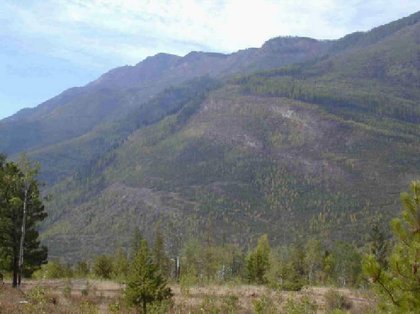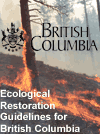 |
|

The Importance of Natural Disturbance Processes
|
Natural ecosystems go through processes of establishment, aging, disturbance,
and renewal. Renewal can be initiated by large wildfires, or by
|
| the toppling of a single old tree. While these natural
disturbances and their subsequent effects are sometimes
actively suppressed by humans due to the perception that they
are harmful and destructive, many organisms and ecosystems depend
on disturbance for survival. For instance, the black cottonwood,
a riparian
tree, times the release of seed to coincide with peak spring
flows of the adjacent river. In years when the river floods
and spills over its banks, cottonwood seed gets widely distributed
downstream (Gayton 2001). In other examples, the unique |
Natural Disturbances
Insect outbreaks, fire, snow press, diseases, ice, storms,
windstorms, avalanches, volcanic eruptions, floods
|
|
|
high-elevation shrub communities created by
repeated snow avalanches are crucial for foraging bears. Many species
of forest birds rely on dead standing trees for nesting habitat,
and seeds of the shrub ceanothus and lodgepole pine both germinate
in response to fire.
|

Tanis Douglas
Thick stands of lodgepole pine on the
site of a 1985 wildfire. Lodgepole pine germinates and thrives in
response to fire.
|
Natural Disturbance as an Agent of Ecosystem Health - Forest Disease
|
| The role of disease-causing tree fungi (e.g. Armillaria
spp. and Fomes spp.) in creating
un-even aged forest stands and valuable wildlife trees is only
now beginning to be appreciated. Where forest pathogens and
pests are traditionally viewed as negative and costly, disease
agents are now sometimes acknowledged to be an integral part
of a healthy ecosystem. The role of some of these agents can
have a profound effect on large areas of anthropogenically-impacted
forests. For example, mountain pine beetle (Dendroctonus
ponderosae Hopkins) attacks older, even-aged lodgepole
pine that have been allowed to establish over extensive areas
due to wildfire suppression. The damage caused by the beetle
kills most of the pine overstory,
and allows different successional
understory
species to establish. While these beetle-killed forests usually
represent serious economic losses, this disease-causing beetle
can actually restore more natural and stable conditions to the
dense forests created by decades of fire control. |
Using
Natural Disturbance Regimes to set Restoration Goals
An
understanding of the local natural disturbance regime will help
a restoration practitioner understand the types, patterns, and ages
of ecosystems that would have been present prior to European influence.
Natural Disturbance Types (NDT) are a useful tool, developed for
British Columbia as part of the Forest Practices Code
Biodiversity
Guidebook (Province of BC 1995). These Types categorize the
Province into zones based on the frequency and severity of pre-European
disturbance events. It is important to note that this definition
of "natural" disturbance includes aboriginal land management
activities such as burning as they were conducted before European
contact (Gayton 2001).
Natural Disturbance Types, as defined in the
Forest Practices Code Biodiversity Guidebook:
|
NDT1: ecosystems with rare stand-initiating events
NDT2: ecosystems with infrequent stand-initiating events
NDT3: ecosystems with frequent stand-initiating events
NDT4: ecosystems with frequent stand-maintaining fires
NDT5: alpine tundra and subalpine parkland
|
The Biodiversity
Guidebook assigns groups of biogeoclimatic
subzones and variants to each NDT, and also provides general guidelines
for forest stand age-class distribution in each of the five categories
(i.e., it provides guidance on landscape-level
ecosystem patterns). The NDT concepts are not specific to the local,
stand level at which most restorations take place; however, the guidebook,
together with biogeoclimatic maps, form valuable starting points
for terrestrial restoration planning (Gayton 2001).
Identifying local-level natural disturbance regimes can be tricky;
for example, the average fire-return interval in a fire-maintained
(NDT4) landscape depends on slope, aspect, elevation, and topography.
However, a variety of techniques can be used to understand your
local disturbance regime (see 'Historic
Reference Ecosystems'), and more information is available all
the time. In general, methods of investigating the former disturbance
regime and disturbance pattern on a site might include coring older
trees, examining fire-scarred trees, assessing soil pits, looking
at historic photos and records, and investigating local knowledge.
| Mimicking
Natural Disturbance - Ecosystem Management in the East Kootenays
|
In recent decades, the effects of fire suppression
have become a cause for concern for many residents of the East Kootenays,
BC. Historically, before widespread settlement and fire suppression
efforts, ground fires would have burned relatively frequently due
to lightning strikes and due to intentional ignitions by First Nations
to increase hunting opportunities. Now, the amount of grassland
and open forest is in serious decline, causing concern to various
sectors of society. Hunters, government managers and ranchers are
concerned about the loss of grassland and open forest habitat, formerly
available to big game species, currently rare and endangered species,
and livestock. Forest managers are also critically concerned about
the risk of cataclysmic fire due to the increase in dense forests
and fuel build-up. Hence, under the Kootenay-Boundary Land Use Plan
(1990), there is wide agreement to manage the area to mimic the
former disturbance regime.
Under the Land Use Plan, the Rocky Mountain Trench is zoned
into the three main types of ecosystems desired: open forest,
grasslands, and closed forest, based on interpretations of old
air photos and site capabilities. It will take decades of selective
logging, in-growth 'slashing', and ground fires to restore the
area closer to how it was when fire was the main disturbance
agent. However, all segments of society are in agreement that
the alternative is not acceptable. The alternative to current
management plans is an ecosystem far removed from its natural
range of variability, with serious impacts to the
plants, animals and humans that depend on it. |
|







